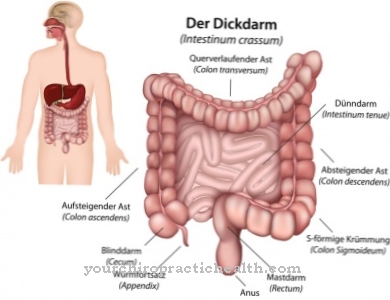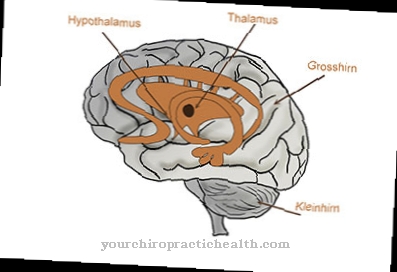The Cranial arteritis is an age-related inflammatory disease of the blood vessels that often affects the large and medium arteries of the head. If left untreated, cranial arteritis has a massive impact on vision.
What is cranial arteritis?

© freshidea - stock.adobe.com
Cranial arteritis is inflammation of the walls of the arteries. Women are affected much more often than men, people of Scandinavian origin more often than other population groups.
The age of onset increases significantly from the age of 50. In most cases, the arteries of the head, especially those of the temples, are affected, which is why the name temporal arteritis is sometimes used. Other names for cranial arteritis are Horton's disease, Temporal arteritis, Giant cell arteritis, or Horton-Magath-Brown syndrome.
Timely treatment for cranial arteritis is critical to prevent permanent tissue damage and loss of vision.
causes
The causes of cranial arteritis cannot yet be clearly proven. Recent molecular biological research has shown that T cells (helper cells) recognize antigens in the vessel wall and so-called macrophages (scavenger cells) send a signal to destroy these alleged pathogens.
A cranial arteritis is therefore also referred to as an autoimmune disease that is of genetic origin. The activation of the phagocytes triggers inflammatory tissue damage, which causes the affected arteries to swell and the blood supply to them increasingly deteriorates.
People at risk for cranial arteritis include people with rheumatoid polymyalgia, systemic lupus erythematosus, rheumatoid arthritis, and severe infections.
You can find your medication here
➔ Medicines for headaches and migrainesSymptoms, ailments & signs
In most cases, the complaints and symptoms of cranial arteritis are relatively clear, so that they point directly to the disease and thus enable early treatment. Those affected primarily suffer from very severe pain in the head area. These headaches are sharp and can spread to neighboring regions.
There is severe pain, especially in the ears or eyes. Furthermore, those affected by cranial arteritis also suffer from severe visual disturbances and, in severe cases, from blindness. The quality of life of the person affected is significantly restricted and reduced by the disease.
Weight loss can also occur with a fever or with general tiredness and fatigue. Often cranial arteritis also leads to severe pain in the muscles and thus to restrictions in movement and in the everyday life of the person concerned. Most patients also suffer from double vision or from extreme sensitivity of the temples.
Cranial arteritis also weakens the patient's immune system, making them generally more susceptible to various diseases. Psychological complaints can also occur due to the symptoms.
Diagnosis & course
The symptoms of cranial arteritis can vary widely. Sometimes the onset of the disease is characterized by muscle stiffness and pain (myalgia) in the shoulders and hips, fever, and fatigue, as with the flu.
However, the most common symptoms of cranial arteritis are often severe headache and tenderness - mostly in both temples. Pain in the jaw and tongue when chewing is also symptomatic. In addition, there is sensitivity in the hair and scalp as well as the characteristic loss of vision or double vision.
If untreated, cranial arteritis can lead to complications such as permanent blindness, an aneurysm or, in individual cases, a stroke.
Cranial arteritis is difficult to diagnose, so other diseases must be ruled out first. A diagnosis is made on the basis of a comprehensive anamnesis with a physical examination and laboratory tests. These check liver values, the rate of sedimentation and the values of certain inflammation markers.
The standard for diagnosing cranial arteritis is a biopsy, and imaging methods such as magnetic resonance angiography, ultrasound or positron emission tomography can also be used.
Complications
The cranial arteritis leads to considerable impairment of vision. In the worst case scenario, the patient can lose all of his eyesight and thereby become blind. Women are more often affected by cranial arteritis than men and consequently suffer more often from the complications of the disease.
Mostly there is a sharp pain in the head, which occurs with visual disturbances or complete blindness. The affected person also suffers from fever and tiredness and from a general feeling of illness. The muscles and extremities are also painful, which greatly reduces the quality of life.
Before going blind, there is haze and double vision. It is not uncommon for patients to suffer a stroke, which in the worst case scenario can even lead to death. The treatment takes place with the help of medication. In most cases the symptoms improve after a few days, although the entire treatment can extend over several years.
Most of the time, the eye problems and high blood pressure are also treated. In many cases, the therapy leads to weight gain and a weakening of the immune system. As a result, the patient is more likely to develop flu and other infections.
When should you go to the doctor?
Cranial arteritis must always be treated by a doctor. If treatment is not received, the disease can have a negative impact on the patient's vision and, in the worst case scenario, lead to complete blindness. For this reason, urgent treatment by a doctor is necessary. As a rule, a doctor should then be consulted if sudden visual disturbances occur that are associated with severe headaches.
Likewise, thick arteries on the temples can be a sign of cranial arteritis and should be examined by a medical professional. In addition, a doctor should be consulted if the patient develops a fever or fatigue and tiredness. It is not uncommon for cranial arteritis to lead to muscle pain or significant weight loss.
Without treatment, it can also lead to a stroke, which can be fatal for the person affected. Usually, cranial arteritis can be diagnosed by a general practitioner. Further treatment takes place with the help of medication and the symptoms are likely to be limited relatively well.
Doctors & therapists in your area
Treatment & Therapy
If cranial arteritis can be diagnosed and treated early, the prognosis is usually very good. Cranial arteritis is treated with high doses (1 mg / kg / day) of corticosteroid drugs such as prednisone.
Because prompt treatment is sought, drug treatment can begin before the diagnosis is confirmed. Despite the fact that an improvement can already occur after a few days, the medication must be taken longer for one to two years or more. After the first few weeks, the dose may be gradually reduced until only a low dose of corticosteroids is required to control the inflammation.
Some of the symptoms may return briefly during treatment. Corticosteroids are powerful anti-inflammatory drugs. Long-term use can therefore cause serious side effects, especially at high doses. These include osteoporosis, high blood pressure, muscle weakness, glaucoma, or cataracts.
Other possible side effects of corticosteroid therapy for cranial arteritis are weight gain, high blood sugar levels and a weakened immune system. Calcium and vitamin D supplements or other drugs are used to treat the side effects.
Outlook & forecast
Cranial arteritis has a good prognosis if diagnosed early and started treatment quickly. With a drug treatment there is the possibility of alleviating the symptoms. For a good and stable healing picture, the treatment must take place over several years. After a few days or weeks, however, a significant improvement is already noticeable.
If the drug is stopped on its own and too early, the disease will relapse and the symptoms reappear. Without medical care, the impairment continues to grow and new symptoms appear. The progressive course of the disease can lead to blindness in the patient under unfavorable conditions. In addition, a stroke may occur in individual cases. This usually leads to lifelong impairments, paralysis and functional disorders. In addition, it can be fatal if treated late or in the absence of intensive care.
The difficulty with cranial arteritis is the diagnosis. The disease is easy to confuse with other diseases because of the symptoms. This means that a doctor's consultation is delayed or the doctor initially misdiagnoses. The delay in the onset of the disease triggers a continuous deterioration in eyesight. Once corrected and treatment begins, the symptoms will gradually subside.
You can find your medication here
➔ Medicines for headaches and migrainesprevention
Prevention of cranial arteritis is not possible. However, coping with the side effects of the drugs is a major challenge. Eating a healthy diet of fresh fruits and vegetables, whole grains, lean meat and fish, and restricting salt, sugar and alcohol is the best basis for countering potential problems. Regular exercise for at least 30 minutes a day strengthens the immune system and well-being in order to get along with the treatment of cranial arteritis.
Aftercare
Follow-up care options for cranial arteritis usually prove to be relatively difficult.In most cases, those affected are dependent on a medical illness. When treating the disease, the patient usually has to take drugs. Care should always be taken to take the medication regularly, and interactions with other medications should also be taken into account.
In most cases, patients are dependent on lengthy treatment. Since the treatment of cranial arteritis can lead to serious side effects, the affected person should have himself checked regularly. A healthy lifestyle with a healthy diet also has a very positive effect on the further course of cranial arteritis.
Weight gain should be avoided in any case. Care by friends and relatives can also have a very positive effect on the course of the disease and prevent further complaints. Contact with other sufferers of cranial arteritis can lead to an exchange of information, which can also have a positive effect on the further course of the disease.
You can do that yourself
Giant cell arteritis is a very serious rheumatic vascular disease that must be treated by a doctor. Those affected should consistently carry out a medically prescribed treatment with cortisone, even if there are undesirable side effects. Patients can also alleviate the latter through self-help measures.
Since the administration of cortisone increases the risk of osteoporosis, calcium should be taken at the same time and sufficient sunlight should be taken or vitamin D substituted. Potential vascular occlusions can be prevented by taking acetylsalicylic acid (ASA), which is contained in many over-the-counter pain relievers. As ASA attacks the gastric mucosa, it should be protected by a proton inhibitor.
Naturopathic methods can also be used to support this. A classic in the treatment of rheumatic complaints is birch, which is used as juice or tea. A brew made from birch leaves can also be applied directly to painful areas of the body. Nettle is also said to have a positive effect on the inflammatory processes in the body. Willow bark is a natural source of ASA and is drunk as a tea, which, however, tastes very unconventional. In the meantime, however, tablets based on willow bark are also available.
Often, movement of the jaw can exacerbate the severe headache that is almost always associated with giant cell arteritis. In the case of acute attacks, those affected should therefore only eat soft or liquid food and never chew heavily.

.jpg)










.jpg)



.jpg)










.jpg)
